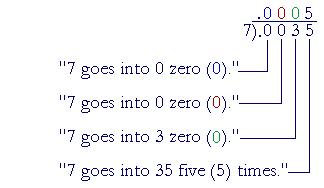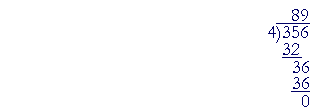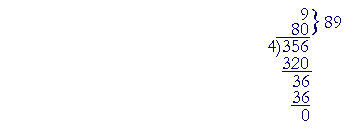|
Lesson 11 SHORT DIVISIONDivision means finding what number times the divisor will equal the dividend. (Lesson 10.) To help us find that number, there is a technique called short division. In this Lesson, we will answer the following:
|
||||||

|
||||||
|
Dividend ÷ Divisor = Quotient Example. Using the division box, write 1 ÷ 4. (There is nothing to calculate.) Answer. 4 is the divisor. It goes outside the box.
Before going on to short division, the student should be clear about division with remainder. |
||||||
| ||||||
|
"7 goes into 25 three (3) times (21) with 4 left over." Write the remainder 4 beside the 2. Continue: "7 goes into 42 six (6) times exactly."
Begin, "5 goes into 17 three (3) times (15) with 2 left over."
Write 3 over the 7 (not over the 1), and write the remainder 2 next to the 9. Continue: "5 goes into 29 five (5) times (25) with 4 left over.
Write 5 over the 9, and write the remainder 4 next to the 8. Finally, "5 goes into 48 nine (9) times (45) with 3 left over."
Write 9 over the 8. The final remainder is 3.
This problem will illustrate the following point:
We will write a digit over the 1, then over the 6, then over the 0, and so on, until finally we write a digit over the 3. Begin, "4 goes into 21 five (5) times (20) with remainder 1 ."
Next, "4 goes into 16 four (4) times exactly."
Next, "4 goes into 0 zero (0)."
Whenever the partial dividend is less than the divisor Next, we must write a digit over the 2: "4 goes into 2 zero (0)."
Now the 2 remains. It is the remainder. Whenever the quotient is 0, that digit beneath it "4 goes into 24 six (6) times exactly."
Finally, "4 goes into 3 zero (0)."
3 is the final remainder. Again, whenever the quotient is 0, the digit beneath it in the dividend remains.
"3 goes into 15 five (5) times. 3 goes into 2 zero (0)." 2 is the remainder. That is, 152 = 50 × 3 + 2. We use short division whenever it is easy to multiply the divisor. Example 4. Harold has a debt of $3,164. He is able to pay $25 a week. How many weeks will it take him to pay the debt? Solution. How many 25's will equal 3,164. To find out, we must divide:
"25 goes into 31 one (1) time (25) with 6 left over."
"25 goes into 66 two (2) times (50) with 16 left over."
"25 goes into 164 six (6) times (150) with 14 left over."
At the end of 126 weeks, then, the debt will be almost paid. $14 will remain. Therefore, it will take Harold 127 weeks.
We have seen that the divisor must be a whole number. We can now consider the case in which the dividend is a decimal. |
||||||
|
||||||
|
"9 goes into 27 three (3) times." "9 goes into 3 zero (0)." Place the point in the quotient. The 3 remains. "9 goes into 36 four (4) times.
Solution. The divisor 7 is a whole number. Place the point: When we have placed the point has been placed, then over each digit in the dividend we must write a digit in the quotient. 
For those students still required to do problems in which the divisor has two or more digits, we include the following example. Note, however, that it can be done with short division.
Example 7.
38 will not go into 1; and it will not go into 17; but it will go into 174. The question is, How many times? To answer, Try the first digit of the divisor, 3, into the first two digits of the dividend, 17.
3 goes into 17 five times. Therefore we do not have to try any number greater than 5. (Because any number greater than 5 × 38 will be too big. 5 × 30 = 150, which is less than 174, but 6 × 30 = 180; too big.) 5, in fact, is too big: 5 × 38 = 150 + 40 = 190. (The student should try to do these simple multiplications mentally. It is the most efficient way to test a digit for the quotient.) 3 will go into 174 four (4) times:
4 × 38 = 120 + 32 = 152 To find the remainder -- what must we add to 52 to get 74? 52 + = 22 = 74 22 is the remainder.
How many times does 38 go into 228? Again, try the first digit of the divisor, 3, into the first two digits of the dividend, 22. Although 3 goes into 22 seven (7) times, 7 is too big: 7 × 38 = 210 + 56 = 266 38 will go in 6 times -- exactly:
6 × 38 = 180 + 48 = 228 Note that we write the 4 in the quotient over the 4 in the dividend, because we are putting 38 into 174. We can then see immediately that the answer will have exactly two digits. This problem may also be done in the conventional style of long division:
4 times 38 is 152. The remainder is 22. Bring down the 8. 38 goes into 228 six (6) times exactly. These written methods are based on Property 5 of division, which leads to decomposing the dividend. For example, 
We say, "4 goes into 35 eight (8) times with remainder 3." But 8 is in the tens place, so we are actually mutiplying 80 × 4 = 320, 
The method itself decomposes 356 into multiples of 4: 320 + 36. At this point, please "turn" the page and do some Problems. or Continue on to the next Section. Introduction | Home | Table of Contents www.proyectosalonhogar.com |
||||||







